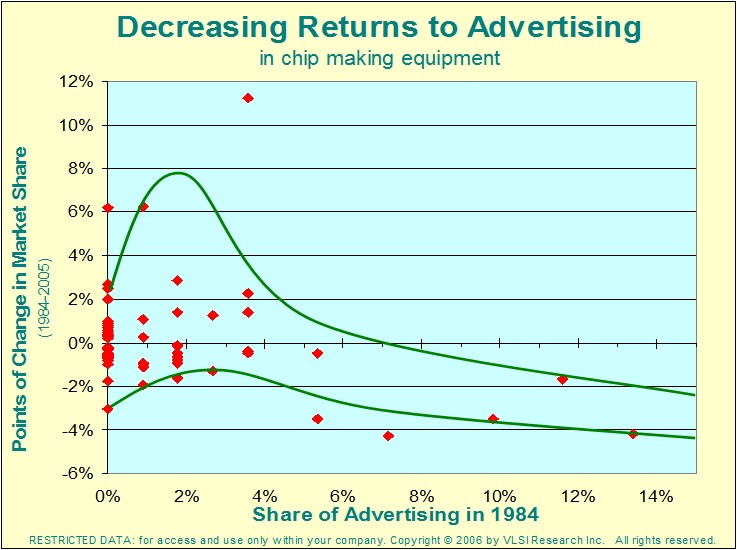Advertising should be primarily used for imprinting your brand on the minds of senior executives and investors
It is easy to waste money advertising Tech – especially when one is selling to industrial clients. It is taught, and many believe, that there is a direct and positive correlation between advertising and revenues. This may be the case when it comes to consumer products, where prices are low, distributors insulate you from the customer, and there are too many customers to market directly. But when it comes to manufacturing industries, sheer scale differences mean that most marketing is better done face-to-face. An advertising blast may sway you when reaching for a Coke™ or a Pepsi™, but it is unlikely to do so when millions and your career are at stake.
Moreover, two dramatic changes in the eighties changed the nature of Tech marketing forever. The first was the deregulation of the airlines and the second was globalization. Deregulation dramatically lowered travel costs. Globalization meant you had to travel more because trade pubs had little reach across international borders. Both worked hand-in-hand to forge these changes. Moreover, the travel industry and countries adapted. Today, you can fly to Europe, pick-up your rental without stopping at the counter, drive across many national borders without stopping, and never have to exchange your money. The difference in business friendliness wrought over the last three decades is huge. One of the most important aspects of this change was that it meant product advertising was no longer relevant in industrial Tech.
The eighties was also a tumultuous time for the chip making equipment industry as well. Only half of the Top 10 from 1984 are serving the industry today. All of them advertised in the trade pubs. In recent issues of prominent trade pubs, only four had ads. This should come as no surprise, as the number of pages in trade pubs today is roughly a tenth of what it was in 1984. Comparing the number of ad page placements of the Top 50 suppliers from 1984 and 2005, one finds a similar reduction of more than 90%.
It is interesting to note that the most successful companies of the post-1985 period were already adapting to these changes. TEL, Nikon, KLA-Tencor, and Applied Materials all had relatively low levels of advertising and all gained market share. It should come as no surprise that all four were early adopters, if not developers, of what I call ‘air-marketing’ principles. In contrast, the least successful – GCA, Eaton, Perkin-Elmer, and General Signal were all heavy advertisers in 1984 – with a space share two to three times their market share. Surely, this didn’t do them in. But it hints that they may not have had a clue as to how to change in the changing environment. As I recall it, they did not readily adopt air-marketing. Their use of airlines might better be described as ‘air-management.’ They simply were not visiting customers as much. The broader picture confirms this view in the table below, where I compare how many points of market share the top chip equipment suppliers from 1984 gained or lost, versus their share of advertising. Another indication of the poor state of marketing awareness in the era is that Motorola and Fairchild were also placing ads in chip making trade pubs.

The first thing to note is that the relationship is not linear. Companies who use advertising will do better. But it may not be necessary to use advertising at all. The worst case, performance from a company who used no advertising, was a loss of 3 percentage points. The best case was just over 6 points. Applied Materials, who accounted for 4% of the placements, tacked on almost 12 points of share over the period. The worst case loss in the 4% range was less than a single point. For Applied, its 4% advertising share was similar to its market share. All who accounted for more than 5% had negative returns. Many were spending in multiples of their market shares, showing the excess had – at best – no effect. The clear danger in the excess is that it diverts attention from other, more productive, pursuits.
The differences go deeper. The companies spending the most tended to have ads that sold products. The companies who got the most out of their spending had ads that tended to sell the company, not its products. The reason why this distinction is important is that customers, who will spend millions, will never do so on the basis of an ad. But their managements who will sign off on their recommendations often do; it is also important to have investor mind share as well; and these two often catalyze decisions when they interact. This is why brand building is so important. It is especially important for smaller companies, because they will find it hard to gain meeting time with customers. Larger suppliers have the ability to crowd out customer calendars, so smaller competitors can’t get in. In this case, advertising must be used as part of a larger strategy to get your foot in the customer’s door. The important thing to remember is to never advertise to sell products or for the sake of advertising being “a good idea.” Always and only advertise for strategic or tactical purposes